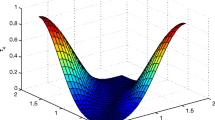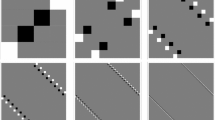Abstract
We elaborate on the recent proposal of employing unitary operators in Quantum Mechanics. The Bell and Mermin inequalities for entangled coherent states are scrutinized by making use of the unitary displacement operators. A violation of the Mermin inequality close to the maximum allowed value is reported, in agreement with the existing literature.
Similar content being viewed by others
Avoid common mistakes on your manuscript.
1 Introduction
In this work we pursue the investigation on the use of unitary operators in order to study the violation of both Bell-CHSH [1, 2] and Mermin [3] inequalities.
Unitary operators \(\{ \mathcal A\}\), \(\mathcal{A}^{\dagger } \mathcal{A} = \mathcal{A}\mathcal{A}^{\dagger }=1\), are a special case of a more general class of operators, \(\{ \mathcal Q \}\), known as normal operators: \(\mathcal{Q}^{\dagger } \mathcal{Q} = \mathcal{Q} \mathcal{Q}^{\dagger }\). Normal operators possess a spectral representation [4], a fundamental tool in Quantum Mechanics. As outlined in [5,6,7], these operators are considered the natural candidates to generalize the notion of observable in Quantum Mechanics. In particular, setting
it follows that the unitary conditions yield
Equation (2) tells us that a unitary operator can be thought as being constituted by two Hermitian commuting operators \((\mathcal{M},\mathcal{N})\) whose eigenvalues belong to the unit circle.
Concerning now the Bell-CHSH and the Mermin inequalities, let us remind their formulation
and
where \(\mathcal{M}_3\) stands for the Mermin operator of order three. The state \(\vert \psi _{AB} \rangle \) refers to a bipartite system AB, while \(\vert \psi _{ABC} \rangle \) to a three-partite system ABC. The operators \((A_1,A_2)\), \((B_1,B_2)\), \((C_1,C_2)\) are Hermitian dichotomic operators fulfilling the conditions
and
One speaks of a violation of the Bell-CHSH inequality whenever
The value 2 is the classical bound, while \(2 \sqrt{2}\) is the maximum allowed violation, the so-called Tsirelson bound [8]. In the case of the Mermin inequality of order three, (4), the violation occurs for [3]
Making use of unitary operators means that, instead of employing operators as in (5). Equation (6), computations are done with operators \((\mathcal{A}, \mathcal{A}')\), \((\mathcal{B}, \mathcal{B}')\), \((\mathcal{C}, \mathcal{C}')\) subjects to the conditions
Replacing (5), (6) by (9) requires a detailed re-examination of both classical and quantum bounds for the Bell-CHSH and Mermin inequalities. From the analysis performed in [7], it follows that the Bell-CHSH and Mermin inequalities can be consistently formulated in terms of unitary operators provided the reality conditions hold:
where
As we shall see, the conditions (10) are fulfilled in the case in which \((\vert \psi _{AB}\rangle , \vert \psi _{ABC}\rangle )\) are entangled coherent states and the operators \((\mathcal{A}, \mathcal{A}')\), \((\mathcal{B}, \mathcal{B}')\), \((\mathcal{C}, \mathcal{C}')\) are identified with the unitary displacement operators. This setup might result in new insights on the study of the properties of entangled coherent states for multipartite systems, while providing a useful application of the unitary operators.
The work is organized as follows. In Section 2 we present the treatment of the Bell-CHSH via unitary displacement operators. Section 3 is devoted to the Mermin inequality of order three. Section 4 collects our conclusion.
2 The Bell-CHSH Inequality via Unitary Displacement Operators
The main tool of the present investigation is the use of the unitary displacement operator
where z is a complex number, \(z=x+iy\), and
stand for the criation and annihilation operators acting on the Hilbert space \(\mathcal{H}_A\) of the subsystem A. Similarly, the displacement operator for the subsystem B reads
where \(w=u+iv\) and \((b,b^{\dagger })\)
being the ladder operators acting on the Hilbert space \(\mathcal{H}_B\). The full Hilbert space is \(\mathcal{H} = \mathcal{H}_A \otimes \mathcal{H}_B\).
For further use, it is worth to write down the main relations which will be employed in the sequel:
where \(\eta \) is a real number. Also
Analogous equations hold for \(\mathcal{D}_b(w)\). Let us proceed by specifying the entangled coherent state \(\vert \psi _{AB} \rangle \) to be used in order to test the Bell-CHSH inequality:
where \(\sigma \) is a real parameter. For the normalization factor \(\mathcal{N}\) one finds
The next step is that os specifying the operators \((\mathcal A, \mathcal A')\), \((\mathcal B,\mathcal B')\). As already underlined, we shall make use of the unitary displacement operators, namely
Therefore, for the Bell-CHSH inequality we have
We see that the displacement operators are employed for defining both the state \(|\psi _{AB}\rangle \) and the Bell operators. This interesting possibility is consistently justified by noticing that the reality condition (10) is fulfilled. In fact, a quick computation shows that
Thus, for the Bell-CHSH correlator we get
The meaning of the above expression is well captured by Fig. 1, where the value of the Bell-CHSH correlator is reported as a function of the parameters \((\eta , \sigma )\) which define the entangled coherent state \(\vert \psi _{AB} \rangle \). The values of the complex numbers \(z=x+iy\), \(z'= x'+ iy'\), \(w=u+iv\), \(w'= u'+ iv'\) have been chosen after an optimization numerical analysis as:
The orange surface shows the behavior of \(< \mathcal{C}>\), while the blue surface corresponds to the classical bound \(< \mathcal{C}> =2\). One sees the existence of a rather big region in which the orange surface is above the blue one. All values of \((\eta , \sigma )\) belonging to this region correspond to violations of the Bell-CHSH inequality. The biggest value of the violation is of about \(< \mathcal{C}>_{\max }\approx 2.23\).
Behavior of the Bell-CHSH correlator \(< \mathcal C>\) as a function of the parameters \((\eta , \sigma )\). The values of the complex numbers \((z,z',w,w')\) are as in (24). The region of the orange surface above the blue one corresponds to a violation of the Bell-CHSH inequality
3 The Mermin Inequality
We move now to the Mermin inequality. The Hilbert space is \(\mathcal{H}= \mathcal{H}_A \otimes \mathcal{H}_B \otimes \mathcal{H}_C\). We need one more pair of ladder operators \((c,c^{\dagger })\):
with
Here, we make use of the same class of entangled coherent states employed by [9, 10], namely
where
Also in this case, the reality condition (10) is fulfilled. In fact, it turns out that
Therefore, for the Mermin inequality one finds
As done in the case of the Bell-CHSH we illustrate, in Fig. 2 the behavior of the Mermin correlator \(\langle M_3\rangle \) as a function of \((\eta , \sigma )\), for the following values of the remaining parameters obtained through a maximization numerical analysis
Again, the orange surface above the blue one shows the region in parameter space in which the Mermin inequality is violated. It is interesting to observe that Fig. 2 is in very good agreement with the results obtained by [9], where the Mermin inequality of order three for coherent states has been addressed by employing different operators \((\mathcal{A},\mathcal{B}, \mathcal{C})\). From Fig. 2 one notices a region, \(\eta ->\rightarrow 38.8525\), \( \sigma \rightarrow 36.5831\), for which the violation of the Mermin inequality is very close to the maximum allowed value, namely: \(\langle \mathcal{M}_3 \rangle _{\max } = 3.99383 \approx 4\). This is exactly the same pattern observed in [9].
4 Conclusion
In this work we have pursued the study of the use of unitary operators in order to analyse both Bell-CHSH and Mermin inequalities. Such a possibility has been put forward by the authors [5], who have underlined the role of the normal operators as the natural class of operators which might be regarded as candidates to generalize the notion of observable in Quantum Mechanics.
Behavior of the Mermin correlator \(< \mathcal{M}_3>\) as a function of the parameters \((\eta , \sigma )\). The values of the complex numbers \((z,z',w,w',\zeta , \zeta ', \tau )\) are as in (31). The region of the orange surface above the blue one corresponds to a violation of the Mermin inequality
As far as unitary operators are concerned, we might give the following overview:
-
as shown in [7], both Bell-CHSH and Mermin inequalities can be consistently formulated in terms of unitary operators, provided the reality conditions (10) are fulfilled.
-
the conditions (10) hold in the case of entangled coherent states, (18), (27), when the operators \((\mathcal{A}, \mathcal{B}, \mathcal{C})\) are identified with the unitary displacement operators, (20), (25). This enables us to employ these operators for defining both states as well as Bell-CHSH and Mermin correlators.
-
As one sees from (23), (30), the explicit calculations for both Bell-CHSH and Mermin inequalities are almost immediate, resulting in rather simple analytic expressions.
-
From Fig. 2 one learns that the violation of the Mermin inequality is nearly close to the maximum value of 4. This result is in agreement with the previous analysis worked out in [9].
-
The displacement operators \((\mathcal{D}_a(z), \mathcal{D}_b(w), \mathcal{D}_c(\zeta ))\) are examples of Weyl operators, characterized by the Weyl algebra [4], namely
$$\begin{aligned} \mathcal{D}_a(z) \; \mathcal{D}_a(z') = e^{\frac{1}{2}(z {z'}^* - z^* z')} \; \mathcal{D}_a(z+z') \;. \end{aligned}$$(32)As such, the present setup can be applied in the cases in which the Weyl algebra is present. As useful examples of such systems we may mention: i) the coordinate-momentum system (q, p) in Quantum Mechanics [11]. For the Weyl operators, we have
$$\begin{aligned} \mathcal{U}_{\delta } = e^{i \delta q} \;, \qquad \mathcal{V}_\omega = e^{i \omega p} \;, \qquad [q,p]=i \;. \end{aligned}$$(33)where \((\delta ,\omega )\) are real parameters. ii) the Weyl operators of a relativistic Quantum Field Theory [12]:
$$\begin{aligned} \mathcal{A}_f = e^{i \int d^4x \;\varphi (x) f(x) } \;, \end{aligned}$$(34)where \(\varphi (x)\) is the scalar quantum field and f(x) a smooth test function with compact support, see [12] and refs. therein. These examples give an idea of the large applicability of the present framework.
Data Availability
No datasets were generated or analysed during the current study.
References
Bell, J.S.: On the Einstein Podolsky Rosen paradox. Phys. Physique Fizika 1, 195 (1964)
Clauser, J.F., Horne, M.A., Shimony, A., Holt, R.A.: Proposed experiment to test local hidden-variable theories. Phys. Rev. Lett. 23, 880 (1969)
Mermin, N.D.: Phys. Rev. Lett. 65, 1838 (1990)
Bratteli, O., Robinson, D.W.: Operator Algebras and Quantum Statistical Mechanics 1, Springer (1997)
Erhard, M., Krenn, M., Zeilinger, A.: Advances in high-dimensional quantum entanglement. Nature Rev. Phys. 2, 365–381 (2020)
Hu, M.-J, Hu, X.-M, Zhang, Y.-S.: Are observables necessarily Hermitian? Quantum Studies: Math. Foundations 4, 243–249 (2017)
Guimaraes, M.S., Roditi, I., Sorella, S.P.: arXiv:2403.15276 [quant-ph]
Tsirelson, B.S.: J. Math. Sci. 36, 557–558 (1987)
Sheng, J.-Q, Lin, L.-H, Zhong, Z.-R, Zheng, S.-B.: Nearly maximal violation of the Mermin-Klyshko inequality with multimode entangled coherent states. Opt. Express 27, 31864–31873 (2019)
De Fabritiis, P., Guedes, F.M., Peruzzo, G., Sorella, S.P.: Phys. Lett. A 486, 129111 (2023). https://doi.org/10.1016/j.physleta.2023.129111. arXiv:2305.04674 [quant-ph]
Work in progress
De Fabritiis, P., Guedes, F.M., Guimaraes, M.S., Peruzzo, G., Roditi, I., Sorella, S.P.: Phys. Rev. D 108(8), 085026 (2023). https://doi.org/10.1103/PhysRevD.108.085026, arXiv:2309.02941 [hep-th]
Acknowledgements
The author would like to thank P. De Fabritiis, F. Guedes, M.S. Guimaraes and I. Roditi for discussions and collaborations. The Brazilian agencies CNPq and FAPERJ are gratefully acknowledged for financial support. S.P. Sorella is a CNPq researcher under contract 301030/2019-7.
Author information
Authors and Affiliations
Contributions
I am the only author of the work
Corresponding author
Ethics declarations
Competing Interests
The authors declare no competing interests.
Additional information
Publisher's Note
Springer Nature remains neutral with regard to jurisdictional claims in published maps and institutional affiliations.
Rights and permissions
Springer Nature or its licensor (e.g. a society or other partner) holds exclusive rights to this article under a publishing agreement with the author(s) or other rightsholder(s); author self-archiving of the accepted manuscript version of this article is solely governed by the terms of such publishing agreement and applicable law.
About this article
Cite this article
Sorella, S.P. Bell’s and Mermin’s Inequalities, Entangled Coherent States and Unitary Operators. Int J Theor Phys 63, 227 (2024). https://doi.org/10.1007/s10773-024-05764-y
Received:
Accepted:
Published:
DOI: https://doi.org/10.1007/s10773-024-05764-y






